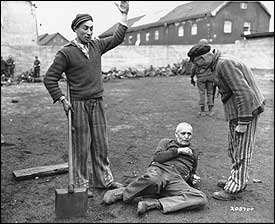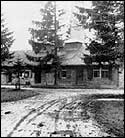
Page 2 of 9 |
Continued from page 1
As an eye blink's worth of springtime light slipped onto black-and-white film from behind a camera's shutter, the dark image that slowly took focus endures today. It is frightful evidence that the evil the Nazis manufactured at their death camps was strong enough to badly cloud the judgment of some Americans who tore down Hitler's barbaric cages.
 Newly liberated Dachau prisoners heap insults on an SS guard after knocking him to the ground.
Newly liberated Dachau prisoners heap insults on an SS guard after knocking him to the ground.(Army Signal Corps Photo) |
In an almost forgotten footnote of history, American investigators concluded that some of the GIs who rounded up elite SS troops during Dachau's liberation were not heroes, but murderers - the ugly underbelly of the Greatest Generation.
''It certainly has to be among the most egregious imaginable examples of misbehavior by the US military in the Second World War,'' said Douglas Brinkley, director of the Eisenhower Center for American Studies at the University of New Orleans. ''It's a low point in an otherwise gallant effort to beat facism. It's an example of what every commading officer does not want to see happen. ... I think the general sentiment about this is: 'Oh, come on. Look how horrible the Nazis were. I would have done the same thing.' We give a bit of empathy to the soldiers who killed the Nazis. And yet, they became very much like the Nazis they were gunning down.''
That sharp assessment is shared by some of the soldiers who witnessed the shootings. When forces have surrendered, their hands in the air, you don't fire, they say. If you do, you cross the line that separates soldier from criminal.
|
|
 'I said: Christ, I'm in the gas chamber ...'
'I said: Christ, I'm in the gas chamber ...'
HANK MILLS
On taking a tour of the camp after it was liberated |
''That is not the American way of fighting,'' Second Lieutenant Daniel F. Drain, who was ordered to set up his machine gun on that unseasonably cool April day, testified at the Army's official inquiry 56 years ago.
But men like General George S. Patton did not believe that. Patton dismissed the murder charges with a flourish, tossing all of the investigative files into a trash can and telling the accused men to go home and get on with their lives, according to two officers interviewed by The Boston Globe.
One copy of the classified investigation survived, however, sandwiched into a gray cardboard box at the National Archives outside Washington, D.C., mislabeled, undisturbed for nearly 50 years, and reviewed by the Globe as the basis for this article.
The investigation was declassified in 1987, before the 3 million pages that have become available in the last few years under the Nazi War Crimes Disclosure Act, some of which have formed the basis for other articles in this series. Yet according to National Archives historian Greg Bradsher, some of the best material was declassified long ago, but never examined by anybody. ''If something has sat here for 50 years and nobody's used it, it's basically news,'' he said.
The report on the Dachau investigation tells a story that has gone virtually unreported in major American newspapers and magazines, meriting just several sentences, for example, in a 1995 US News & World Report account of the 50th anniversary of Dachau's liberation.
Inside those archived files, however, is gripping testimony of citizen-soldiers -- some of them just teenagers at the time -- who never forgot the moment they confronted the devilish divide between good and evil. Walk a mile in my boots, those men later would implore, before passing judgment on what happened that day at Dachau.

